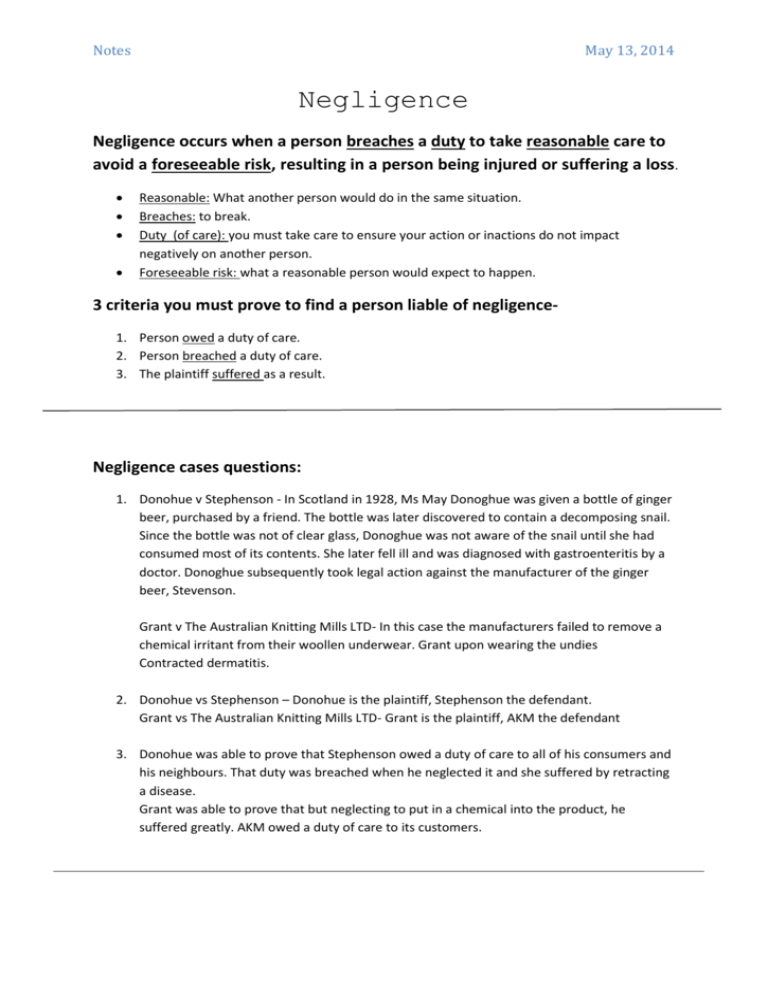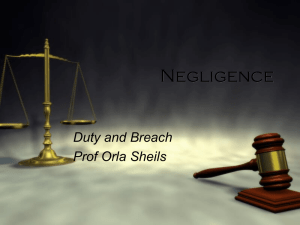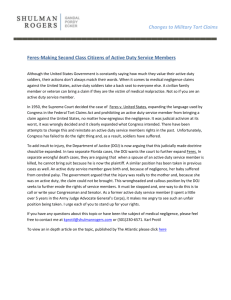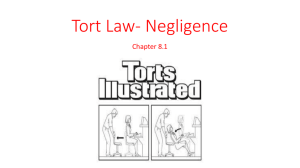Notes - Lara Cross
advertisement

Notes May 13, 2014 Negligence Negligence occurs when a person breaches a duty to take reasonable care to avoid a foreseeable risk, resulting in a person being injured or suffering a loss. Reasonable: What another person would do in the same situation. Breaches: to break. Duty (of care): you must take care to ensure your action or inactions do not impact negatively on another person. Foreseeable risk: what a reasonable person would expect to happen. 3 criteria you must prove to find a person liable of negligence1. Person owed a duty of care. 2. Person breached a duty of care. 3. The plaintiff suffered as a result. Negligence cases questions: 1. Donohue v Stephenson - In Scotland in 1928, Ms May Donoghue was given a bottle of ginger beer, purchased by a friend. The bottle was later discovered to contain a decomposing snail. Since the bottle was not of clear glass, Donoghue was not aware of the snail until she had consumed most of its contents. She later fell ill and was diagnosed with gastroenteritis by a doctor. Donoghue subsequently took legal action against the manufacturer of the ginger beer, Stevenson. Grant v The Australian Knitting Mills LTD- In this case the manufacturers failed to remove a chemical irritant from their woollen underwear. Grant upon wearing the undies Contracted dermatitis. 2. Donohue vs Stephenson – Donohue is the plaintiff, Stephenson the defendant. Grant vs The Australian Knitting Mills LTD- Grant is the plaintiff, AKM the defendant 3. Donohue was able to prove that Stephenson owed a duty of care to all of his consumers and his neighbours. That duty was breached when he neglected it and she suffered by retracting a disease. Grant was able to prove that but neglecting to put in a chemical into the product, he suffered greatly. AKM owed a duty of care to its customers. Notes May 13, 2014 Scenario/ letter to parents of Mark- Dear Marks mother/father, I am writing to inform you of the possible legal action you could take to give your son compensation. Someone’s negligence in the construction zone was a factor in your son’s injury. In order to find somebody liable for criminal negligence, you must prove that they owed and breached a duty of care and that somebody suffered because of it. People that might fall into all three categories are the brick layer, builder, property owner and the local council. My legal advice is that the builder/brick layer is the most directly responsible. They owed a duty of care for whoever uses their building and everything in it. By failing to put danger signs in the construction site, they put many people in danger. A reasonable person would have predicted young, curious children wanting to play in the site and they would have taken the proper procedures to prevent it. The builder/bricklayer was careless. The local council may also be responsible. They owe a duty of care to their community and when they signed a construction release they also should check up on the building site. By failing to check the site and notice the lack of signs, they put many people in danger as well. Whether I recommend suing the property owner or not depends on circumstances. If he was not involved in the planning of the construction in any way, then he could not be liable. Most land owners hand the building over to the company and leave town until it is finished. If this is the case he could not know what was going on and could not have seen a risk. However, if he helped design the home and stayed close to watch over its progress then he should have seen the obvious danger. One thing that may come up in court is that your child never should have been in the construction site in the first place. The defendant will use that against you and say that no duty of care was owed because of that. However, due to the absence of warning signs and barriers a lot of people, especially children, couldn’t have known not to enter. If you decide to take legal action, remember the costs of lawyers and how the whole process might impact your family. There is no guarantee that you will win but I believe that it is more than likely.










